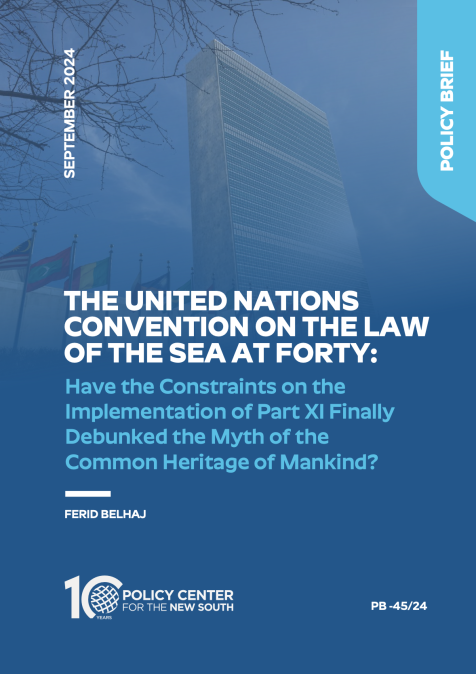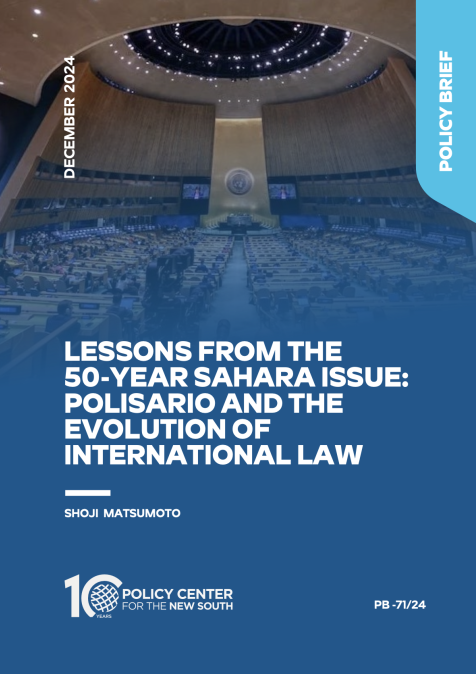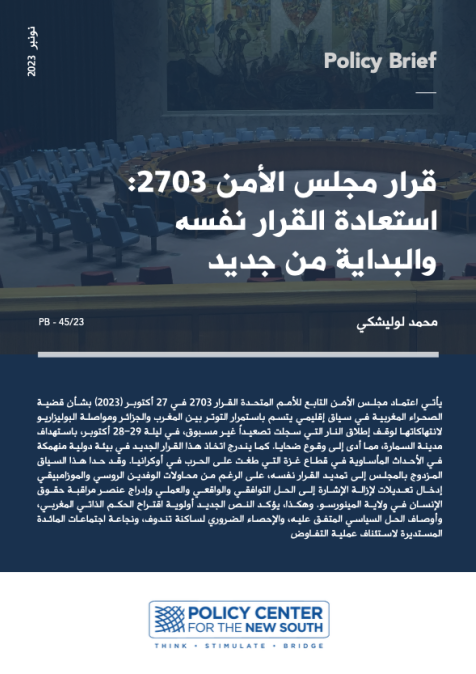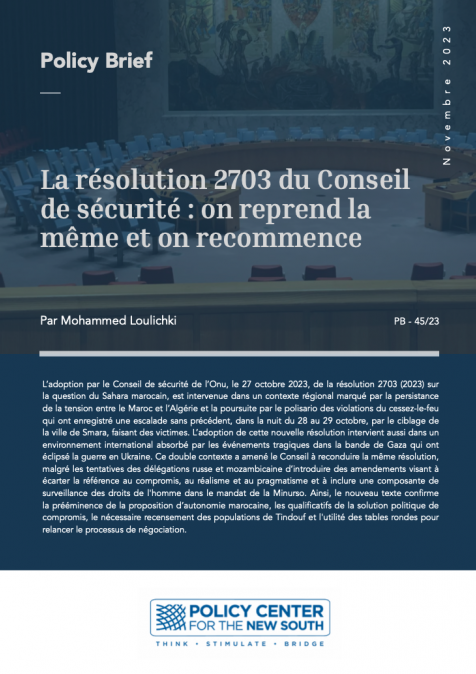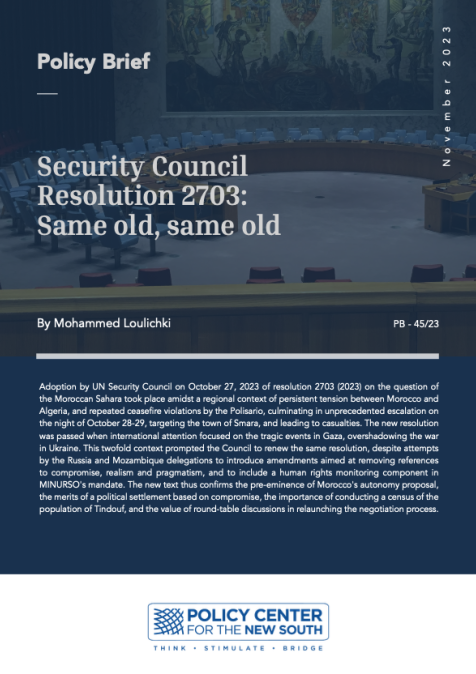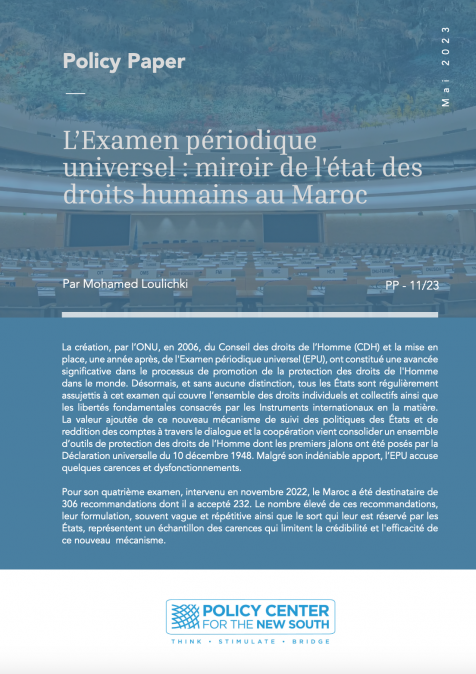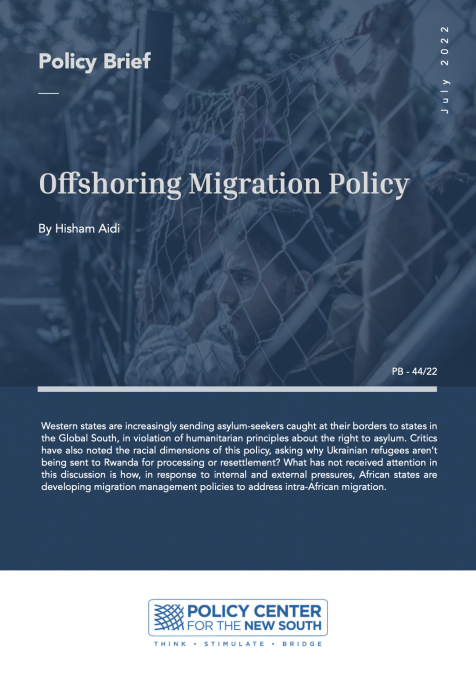Publications /
Policy Brief
As the United Nations Convention on the Law of the Sea marks forty years since its entry into force, questions persist about its success in delivering equitable access to seabed resources beyond national jurisdictions for developing countries. Part XI of the Convention, which introduced the revolutionary concept of the Common Heritage of Mankind, promised to level the playing field. Yet, the compromises made during negotiations—delaying its implementation by 12 years—have left that vision largely unfulfilled. This paper examines the constraints that undermined this ideal and calls for a moratorium on deep- seabed mining. With environmental and ethical concerns looming large, it argues that the seabed’s riches should be preserved for future generations until technology allows for sustainable exploitation.
Introduction
On November 16, 2024, the United Nations Convention on the Law of the Sea (UNCLOS) will celebrate the fourteenth anniversary of its entry into force. UNCLOS represents a landmark in international law, providing a comprehensive legal framework governing all aspects of ocean space, including navigation, resource management, and environmental protection. Adopted in 1982, UNCLOS established crucial legal principles that have shaped the modern law of the sea. Among its various parts, Part XI, which governs the deep seabed and ocean floor beyond national jurisdiction (the ‘Area’), is particularly significant for its embodiment of the principle of the ‘Common Heritage of Mankind’. This principle asserts that the resources of the deep seabed are the collective property of humanity and should be managed in a manner that benefits all, with particular attention to the interests of developing countries.
To better contextualize this paper’s main argument, that UNCLOS—at least when it comes to Part XI—has ended up reneging on its ambitious and generous promises, and turned into a ‘convention for the rich’, it is important to stress the importance of the principle of the common heritage of mankind (CHM), which emerged in international law in the latter half of the twentieth century as a response to growing concerns about the exploitation of global commons—areas and resources beyond national jurisdiction, such as the deep seabed, outer space, and Antarctica. This principle posits that those resources should not be owned by any one nation but rather managed collectively for the benefit of all humanity, with a particular emphasis on equity and sustainable use.
The origins of the CHM principle can be traced back to the decolonization period and the New International Economic Order (NIEO) movement of the 1960s and 1970s, when newly independent states sought to reform the global economic system to address inequalities between developed and developing nations. A 1967 speech by Maltese diplomat Arvid Pardo at the United Nations General Assembly was pivotal in promoting the concept, particularly in relation to the deep seabed. Pardo argued that the deep seabed and its resources should be preserved as the common heritage of mankind, not subject to national appropriation or commercial exploitation without international regulation.
This idea was recognized formally in a 1970 United Nations General Assembly Resolution 2749 (XXV), which declared the deep seabed beyond national jurisdiction as the common heritage of mankind. The principle was later enshrined in UNCLOS, particularly in Part XI, which established an international regime for the exploration and exploitation of the deep seabed, including mechanisms for equitable sharing of benefits.
The CHM principle has also been referenced in other international treaties, such as the 1979 Moon Agreement, and the 1992 Convention on Biological Diversity. However, its application has faced challenges, particularly in balancing the interests of developed and developing nations, and in adapting to new technological and economic realities.
Despite the ambitious vision laid out in Part XI, the implementation of these provisions has been fraught with challenges. The Convention only entered into force in 1994, twelve years after its adoption, following intense negotiations, and amendments that sought to address concerns primarily raised by developed countries. The resulting deep-seabed regime remains uncertain, with ongoing debates over the equitable sharing of benefits and the protection of the marine environment. Moreover, the initial promise that the application of the CHM principle would provide a significant opportunity for developing countries to assert their interests and benefit from ocean resources has been largely unfulfilled.
This paper explores the constraints that have hindered the implementation of Part XI over the past four decades. It will examine the economic, legal, institutional, environmental, and ethical challenges, with a focus on the missed opportunities for developing countries. Based on this analysis, the paper argues that the current regime, while operational, still falls short of realizing the equitable vision of the Common Heritage of Mankind. The paper also argues that, more than developing countries’ powers of persuasion—largely non-existent—recent environmental concerns have been central to the relative preservation of the mineral resources of the area beyond national jurisdictions (i.e. in the Area) from their fierce and uncontrolled exploitation by the mining companies of industrialized countries.
Historical Context and Development of Part XI
Entry into Force in 1994
The United Nations Convention on the Law of the Sea was with much fanfare and trepidation adopted in 1982, but did not enter into force until 1994, a full twelve years later. The delay was largely due to the contentious nature of Part XI, which was resisted by several developed countries, most notably the United States. These countries argued that the original provisions of Part XI, particularly those related to the regulation of deep-sea mining and the redistribution of benefits, were overly restrictive and could deter investment in the exploration and exploitation of seabed resources. In fact, the drafters of UNCLOS envisioned a framework that would ensure equitable access and distribution of resources from the seabed, particularly in areas beyond national jurisdiction. The philosophy behind this was rooted in a desire to prevent a ‘race to the bottom’ in which powerful nations and corporations could monopolize valuable resources, leaving poorer nations without any benefit.
Part XI also reflects a commitment to sustainable development, environmental protection, and the recognition that the exploitation of seabed resources must be conducted with due regard for the interests of future generations. This is why the International Seabed Authority (ISA) was established under UNCLOS: to regulate exploration and exploitation, ensuring that activities are conducted responsibly and that benefits are shared equitably.
In essence, Part XI underscores a global ethos of cooperation, equity, and stewardship over the Earth’s shared resources, aiming to balance the rights of nations with their responsibilities to humanity and the environment.
After much debate and what one can consider as a renunciation from a divided and overall poorly mobilized Group of 77 (G-77)—a coalition of developing nations—entry into force of UNCLOS was facilitated by the adoption of the 1994 Agreement Relating to the Implementation of Part XI (the Agreement), an agreement that ran afoul of Article 18 of the 1969 Vienna Convention on the Law of Treaties, which addresses the obligations of a state in relation to a treaty it has signed but not yet ratified. Article 18 establishes the principle that a state must refrain from actions that would defeat the object and purpose of a treaty, particularly if:
1- The State has signed the treaty: A state that has signed a treaty is obligated to avoid any actions that would undermine the treaty’s objectives before it decides whether to ratify or not.
2- The State has expressed its consent to be bound by the treaty: If a state has agreed to be bound by a treaty, even before it has officially ratified it, the state is expected to uphold the treaty’s aims.
In this instance, a large number of developed countries, signatories of the UNCLOS, adopted an Agreement that introduced significant modifications aimed at making the deep seabed regime more attractive to industrialized nations.
Significant changes included the introduction of a ‘parallel system’ of mining, which allowed private entities from developed countries to operate alongside the International Seabed Authority (ISA), and the reduction of financial obligations imposed on mining entities. The Agreement also provided for a more ‘flexible’ decision-making processes within ISA, which was intended to address concerns about bureaucratic inefficiency, but was in reality to make ISA into an inefficient body with a mission to not question the data, information and requests coming from industrialized nations’ private entities.
However, while the 1994 Agreement enabled UNCLOS to enter into force, it also created a more complex and uncertain deep seabed regime. The parallel system of mining, while intended to encourage investment, has raised questions about the equitable distribution of benefits, particularly in light of the significant differences in the technological and financial resources of developed and developing countries.
The Uncertain Deep Seabed Regime
The regime established by Part XI and the 1994 Agreement remains uncertain in several key areas, particularly the regulation of deep-sea mining and the equitable sharing of benefits. ISA is responsible for overseeing activities in the Area and ensuring that the exploitation of resources is conducted in a manner that benefits all humanity. However, ISA has faced significant challenges in fulfilling its mandate, and the deep seabed regime remains underdeveloped in several respects.
One of the main sources of uncertainty is the regulatory framework governing deep-sea mining. While ISA has established some regulations and guidelines, significant gaps remain, particularly in relation to environmental protection and the equitable sharing of benefits. The current framework relies heavily on environmental impact assessments (EIAs) conducted by mining contractors, but there are concerns about the transparency and rigor of these assessments. Furthermore, the lack of a comprehensive environmental management strategy for the deep seabed has led to fears that mining activities could cause irreversible damage to fragile marine ecosystems.
Another area of uncertainty is the financial regime for deep-sea mining. The 1994 Agreement sought to make the financial terms more attractive to investors by reducing the fees and royalties imposed on mining activities. However, this has led to concerns that the benefits accruing to developing countries, which were a central part of the CHM principle, may be insufficient. The mechanism for distributing these benefits remains underdeveloped, and there is ongoing debate on how to ensure that developing countries receive a fair share of the proceeds from deep-sea mining.
Lost Opportunity for Developing Countries
One of the most significant critiques of the implementation of Part XI is that it has failed to deliver on its promise to empower developing countries and ensure that they benefit equitably from the resources of the deep seabed. The CHM principle was intended to prevent the monopolization of these resources by technologically advanced nations, and to provide a significant source of revenue for developing countries. However, the reality has fallen far short of these aspirations.
1. Marginalization in Decision-Making
Developing countries have struggled to make their voices heard within the Preparatory Commission for the Establishment of the International Seabed Authority (the Prepcom), and within ISA, where decision-making has often been dominated by wealthier nations with greater financial and technological resources. Although ISA operates on the principle of consensus, in practice, the interests of developed countries, which possess the capabilities to engage in deep-sea mining, have often taken precedence. This has led to a situation in which the concerns and priorities of developing countries, particularly regarding the equitable sharing of benefits and the protection of the marine environment, have been marginalized.
2. Limited Participation in Deep-Sea Mining
The technological and financial barriers to entry in the deep-sea mining industry have largely excluded developing countries from participating in the exploitation of the Area’s resources. While ISA has made provisions for the participation of developing countries, including through joint ventures and technology transfer agreements, these mechanisms have been underutilized and have not provided meaningful opportunities for developing countries to engage in deep-sea mining.
The promise of technology transfer, which was a key component of the original Part XI provisions, has been particularly disappointing. Developed countries have been reluctant to share the advanced technologies required for deep-sea mining, citing concerns about intellectual property rights and the high costs associated with developing and transferring these technologies. As a result, developing countries have remained largely dependent on the expertise and resources of developed nations, limiting their own ability to independently exploit the resources of the deep seabed.
3. Inequitable Distribution of Benefits
The distribution of benefits derived from deep-sea mining is another area in which the implementation of Part XI has fallen short. The current financial regime, as modified by the 1994 Agreement, has been criticized for prioritizing the interests of developed countries and private investors over those of developing nations.
The financial terms established under the 1994 Agreement significantly reduced the fees and royalties that mining entities are required to pay, which has limited the amount of revenue available for distribution to developing countries. Moreover, the mechanism for distributing these benefits remains underdeveloped, and there is a lack of transparency and accountability in how these funds are managed and allocated. This has led to concerns that the resources of the deep seabed are being exploited in a manner that primarily benefits wealthy nations, rather than contributing to the economic development of the global community as a whole.
Constraints on Implementation
1. Economic Constraints
Investment and Technology
The economic and technological challenges associated with deep-sea mining have been among the most significant barriers to the implementation of Part XI. The exploration and exploitation of mineral resources in the Area require substantial investment in advanced technology, which is often beyond the reach of many developing countries. The high costs associated with these activities have deterred private companies from investing in deep-sea mining, particularly given the regulatory uncertainties and environmental risks involved.
The reluctance of private investors is further exacerbated by the long lead times before deep-sea mining projects become profitable. Unlike land-based mining, which benefits from established infrastructure and supply chains, deep-sea mining is a nascent industry with limited precedents. As a result, the financial risks associated with these ventures are considerable, making it difficult to attract the necessary capital.
Global Economic Disparities
The economic gulf between developed and developing countries has also posed a significant challenge to the equitable implementation of Part XI. While the CHM principle emphasizes the need for the benefits derived from the Area to be shared equitably, the reality is that wealthier nations possess the financial and technological resources necessary to exploit these resources. This imbalance has led to concerns that the benefits of deep-sea mining may disproportionately accrue to developed countries, contrary to the spirit of Part XI.
Moreover, the costs associated with environmental protection and sustainable resource management in the Area are significant, and developing countries often lack the financial resources to participate fully in these activities. This has led to a situation in which the management and exploitation of the Area are increasingly dominated by a few wealthy nations and multinational corporations, undermining the goal of equitable distribution of benefits.
2. Legal and Institutional Constraints
Complex Legal Framework
The legal framework established by UNCLOS, particularly Part XI and the subsequent 1994 Implementation Agreement, is characterized by a high degree of complexity. This complexity stems from the multifaceted nature of the issues UNCLOS addresses, including resource management, environmental protection, technological transfer, and the equitable sharing of benefits. The intricate legal provisions, combined with the broad range of stakeholders—including sovereign states, international organizations, private entities, and civil society—have created a challenging environment for effective implementation.
One of the primary legal challenges is the coordination and harmonization of national and international laws. While UNCLOS establishes a comprehensive framework for the governance of the world’s oceans, its effectiveness is contingent on its integration into the national legal systems of its signatory states. However, there is significant variation in how different countries have incorporated UNCLOS provisions into their domestic legal frameworks. This variation often leads to inconsistencies and gaps in the application of international law, particularly in relation to deep-sea mining regulations, environmental protection measures, and the equitable sharing of benefits.
Moreover, the dynamic nature of ocean-related activities, including the ongoing exploration and exploitation of new marine resources, necessitates continuous updates to and adaptations of the legal framework. However, the formal processes for amending or updating UNCLOS provisions are slow and cumbersome, often requiring lengthy negotiations and consensus among a large number of states with diverse interests. This rigidity has made it difficult to respond to emerging challenges and technological advancements in a timely manner, leading to legal uncertainty and gaps in governance.
Jurisdictional Challenges
Another significant legal constraint is the issue of jurisdiction. Part XI of UNCLOS governs activities in the Area, which lies beyond the national jurisdiction of any single state. The practical implementation of the CHM principle has proven challenging, particularly concerning the exercise of jurisdiction over activities in the Area.
ISA is the primary body responsible for regulating activities in the Area, but its jurisdiction is limited to areas beyond national jurisdiction. This creates a legal vacuum in cases in which activities in the Area have transboundary impacts, or when states seek to extend their jurisdictions through claims to extended continental shelves. The overlapping jurisdictions of coastal states and ISA, particularly in regions where the continental shelf extends beyond 200 nautical miles, have led to disputes and legal ambiguities.
Disputes over the delineation of the outer limits of the continental shelf can affect the allocation of seabed resources. Some states have submitted claims to the Commission on the Limits of the Continental Shelf (CLCS), seeking to extend their jurisdictions over areas that overlap with the Area regulated by ISA. These overlapping claims can lead to conflicting legal obligations and uncertainties about the applicable legal regime, complicating the effective governance of the Area.
Enforcement Mechanisms
The enforcement of Part XI provisions and the broader UNCLOS framework presents another significant legal challenge. While UNCLOS establishes legal obligations for state parties, the mechanisms for enforcing these obligations are limited and often rely on the goodwill and cooperation of states. The lack of robust enforcement mechanisms has hindered the effective implementation of UNCLOS, particularly in relation to the regulation of deep-sea mining and environmental protection.
ISA has limited enforcement capabilities. It relies primarily on member states to enforce its regulations and decisions within their jurisdiction, but this decentralized approach has led to inconsistent enforcement and regulatory gaps. For example, while ISA can issue contracts for exploration and exploitation in the Area, it lacks the capacity to monitor compliance directly, and must rely on the reports provided by the contractors and their sponsoring states.
Moreover, the dispute settlement mechanisms established under UNCLOS, including the International Tribunal for the Law of the Sea (ITLOS) and arbitration procedures, are often slow and limited in scope. While these mechanisms provide avenues for resolving disputes between states, they are less effective in addressing non-compliance by private entities, or in situations in which state parties are unwilling or unable to enforce regulations within their jurisdictions.
3- Institutional Challenges
Fragmentation of Governance
One of the most significant institutional constraints to the implementation of Part XI is the fragmentation of ocean governance. The governance of the world’s oceans is characterized by a complex web of international organizations, treaties, and regulatory bodies, each with its mandate, jurisdiction, and areas of expertise. This fragmentation has led to overlapping responsibilities, conflicting mandates, and a lack of coordination among the various institutions involved in ocean governance.
ISA, while the primary body responsible for regulating activities in the Area, operates within this broader context of fragmented governance. It must coordinate with other international organizations, including the International Maritime Organization (IMO), the United Nations Environment Program (UNEP), and regional fisheries management organizations (RFMOs), to address the multifaceted challenges of ocean governance. However, the lack of a coherent and integrated approach to ocean governance has hindered the effective implementation of Part XI, particularly in relation to environmental protection and the sustainable management of marine resources.
For example, the regulation of marine pollution and the protection of biodiversity in the Area require coordination between ISA and other organizations, such as the IMO, which regulates shipping, and UNEP, which oversees global environmental policies. However, the division of responsibilities and the lack of a unified regulatory framework have led to gaps in governance, particularly in areas where the mandates of different organizations overlap or conflict.
Capacity and Resource Constraints
The effective implementation of Part XI also faces significant institutional capacity and resource constraints. ISA operates with limited financial and human resources. The Authority’s budget is funded primarily through contributions from member states, but the level of funding has often been insufficient to meet the growing demands of its regulatory and oversight functions.
ISA’s capacity constraints are particularly evident in its ability to conduct independent monitoring and enforcement of deep-sea mining activities. While the Authority has established regulations requiring contractors to conduct environmental impact assessments and submit regular reports, it lacks the resources to verify the accuracy and completeness of these reports independently. This reliance on self-reporting by contractors has raised concerns about the effectiveness of the ISA’s oversight and the potential for non-compliance with environmental and other regulations.
ISA’s capacity constraints have also affected its ability to develop and implement comprehensive policies for the equitable sharing of benefits from deep-sea mining. The Authority’s limited resources have hindered its ability to conduct research, develop policy recommendations, and engage in capacity-building activities for developing countries. This has contributed to the perception that ISA has been more responsive to the interests of developed countries and private investors than to the needs of developing nations, undermining the equitability principles of Part XI.
Political and Strategic Interests
The implementation of Part XI has also been constrained by the political and strategic interests of key states. The negotiation and adoption of UNCLOS were shaped by the geopolitical dynamics of the Cold War era, with states seeking to protect their strategic interests in the oceans. These dynamics have continued to influence the implementation of Part XI, particularly in relation to the regulation of deep-sea mining and the distribution of benefits.
Developed countries have often prioritized their strategic and economic interests over the equitable distribution of benefits. This was reflected in the 1994 Implementation Agreement, which introduced significant modifications to Part XI to address the concerns of developed countries, particularly regarding the regulation of deep-sea mining and the financial obligations of mining entities.
The political influence of these states within ISA has also shaped the development of the Authority’s regulations and policies. While ISA operates on the principle of consensus, the decision-making process has often been dominated by the interests of wealthier nations, which have greater representation and influence within the Authority’s governing bodies. This has led to concerns that the implementation of Part XI has been skewed in favor of developed countries, at the expense of the equitable principles that underpin the Common Heritage of Mankind.
4- Ethical Constraints
Equity and Justice
The CHM principle embedded in Part XI is inherently tied to notions of equity and justice, particularly concerning the distribution of benefits derived from the exploitation of deep-sea resources. However, the implementation of this principle has been fraught with ethical challenges.
Intergenerational Equity
The ethical concept of intergenerational equity, which refers to the responsibility of the current generation to manage resources in a way that does not compromise the ability of future generations to meet their needs, is also central to the implementation of Part XI. The exploitation of deep-sea resources, particularly in the context of mining, raises significant ethical concerns about the long-term impacts on the marine environment and on the sustainability of ocean resources for future generations.
Environmental Degradation
One of the most pressing ethical concerns related to deep-sea mining is the potential for environmental degradation. The deep seabed is home to unique and fragile ecosystems that are not fully understood by scientists. The extraction of minerals from these environments could lead to irreversible damage, including the destruction of habitats, loss of biodiversity, and the disruption of ecosystem services that are vital to the health of the planet. Given the limited knowledge of deep-sea environments and the long-term effects of mining activities, there is an ethical obligation to exercise caution and prioritize the protection of these ecosystems.
The principle of intergenerational equity requires that the current generation manages these resources in a way that preserves their availability and quality for future generations. However, the commercial pressures driving the rush to exploit deep-sea minerals may lead to decisions that prioritize short-term economic gains over long-term environmental sustainability. This tension between immediate economic interests and long-term environmental stewardship presents a significant ethical dilemma.
Knowledge Gaps and Precautionary Principle
The ethical challenges posed by deep-sea mining are further compounded by significant knowledge gaps about the deep-sea environment and the potential impacts of mining activities. The deep seabed is one of the least explored and understood regions of the planet, and the full ecological consequences of mining are still largely unknown. This lack of knowledge raises serious ethical questions about the prudence of proceeding with mining activities without a comprehensive understanding of the risks involved.
The precautionary principle, which advocates for caution in the face of uncertainty and potential harm, is a key ethical consideration in this context. It suggests that in the absence of conclusive evidence that deep-sea mining will not cause significant harm to the environment, it would be ethically irresponsible to proceed with large-scale extraction. This principle aligns with the broader ethical obligation to protect the marine environment for future generations and to avoid actions that could lead to irreversible damage.
Rights of Indigenous Peoples and Local Communities
The exploitation of deep-sea resources also raises ethical concerns about the rights of indigenous peoples and local communities, which may be affected by mining activities. While deep-sea mining primarily occurs in areas beyond national jurisdiction, the broader impacts of these activities—such as changes in ocean currents, pollution, and the loss of marine species—can affect coastal communities, particularly those that rely on the ocean for their livelihoods and cultural practices.
There is an ethical obligation to ensure that the voices and rights of these communities are considered in the decision-making processes related to deep-sea mining. This includes respecting their traditional knowledge, ensuring their participation in consultations, and protecting their livelihoods and cultural heritage from the potentially harmful impacts of mining. Failure to do so would constitute a violation of the ethical principles of justice and respect for human rights.
Ethical Governance
The governance of the Area under Part XI of UNCLOS is itself subject to ethical scrutiny. Ethical governance in this context would require greater transparency, accountability, and inclusiveness in the decision-making processes of ISA and other relevant bodies. It would also necessitate a commitment to equity in the distribution of benefits and a focus on the long-term sustainability of the marine environment. Ethical governance is not just about following legal procedures; it also involves upholding the principles of justice, equity, and environmental stewardship in all aspects of ocean governance.
6- Environmental Constraints
Marine Ecosystem Vulnerability
The deep-sea environment is characterized by extreme conditions, such as high pressure, low temperatures, and limited light, which have given rise to unique and often fragile ecosystems. These ecosystems include hydrothermal vent communities, cold seeps, and abyssal plains, all of which host species that are highly adapted to their specific environments. However, this specialization also makes these species and ecosystems particularly vulnerable to disturbance, such as that caused by deep-sea mining and other extractive activities.
The extraction of minerals from the seabed involves processes that can cause significant physical disturbance, including the removal of substrate, the creation of sediment plumes, and the destruction of habitats. These activities can lead to the loss of biodiversity, as many deep-sea species have limited ranges and slow reproductive rates, making them particularly susceptible to extinction. The potential for long-term and possibly irreversible damage to these ecosystems is a significant environmental constraint on the implementation of Part XI.
Cumulative Environmental Impacts
In addition to the direct impacts of deep-sea mining, there is growing concern about the cumulative environmental impacts of multiple extractive activities in the deep sea. These cumulative impacts include the combined effects of mining, fishing, pollution, and climate change, all of which can interact in complex ways to exacerbate environmental degradation. For example, the release of pollutants from mining operations could compound the effects of ocean acidification and warming, further stressing marine ecosystems.
The concept of cumulative impacts is particularly relevant in the context of Part XI because the Area is intended to be managed as a global commons, with activities governed by the CHM principle. However, the current regulatory framework under ISA does not fully address the issue of cumulative impacts, and there is a lack of comprehensive environmental management plans that take into account the combined effects of multiple activities over time. These shortcomings place a significant constraint on the sustainable management of the Area’s resources and the protection of the marine environment.
Environmental Monitoring and Compliance
Effective environmental monitoring and compliance are critical to ensuring that the activities regulated under Part XI do not cause undue harm to the marine environment. However, ISA faces significant challenges in implementing robust monitoring and compliance mechanisms. These challenges include limited financial and technical resources, the vast and remote nature of the deep-sea environment, and the reliance on self-reporting by contractors.
The current monitoring regime under the ISA largely depends on the EIAs submitted by contractors and the subsequent environmental management plans (EMPs). While these documents are essential for assessing and mitigating the potential environmental impacts of mining activities, there are concerns about their adequacy and the transparency of the process. Moreover, ISA’s ability to independently verify the information provided by contractors is limited, raising questions about the effectiveness of the monitoring and compliance framework.
Climate Change Considerations
Climate change is an overarching environmental challenge that intersects with the implementation of Part XI in several ways. The deep sea plays a crucial role in global climate regulation, including through the sequestration of carbon and the regulation of oceanic currents. Disturbances to deep-sea ecosystems caused by mining and other extractive activities could have far-reaching effects on the global climate system.
For example, the disruption of carbon sequestration processes in the deep sea could lead to the release of stored carbon into the atmosphere, exacerbating global warming. Similarly, changes in oceanic currents caused by seabed disturbance could affect climate patterns and marine ecosystems on a global scale. The potential for these far-reaching and interconnected impacts underscores the need for a comprehensive approach to environmental governance that integrates climate-change considerations into the management of the Area.
Sustainability and Resource Management
The concept of sustainability is central to the environmental constraints associated with the implementation of Part XI. Sustainable resource management requires balancing the exploitation of deep-sea resources with the protection of the marine environment and the long-term health of ocean ecosystems. However, achieving this balance is challenging given the uncertainties and risks associated with deep-sea mining and the broader environmental impacts of human activities in the oceans.
ISA has established guidelines for the sustainable management of the Area’s resources, but the effectiveness of these guidelines depends on their implementation and enforcement. Moreover, there is an ongoing debate about what constitutes sustainable practices in the context of deep-sea mining, particularly given the unique and largely unexplored nature of the deep-sea environment. The lack of consensus on sustainability standards and the need for more comprehensive scientific research are significant constraints on the effective implementation of Part XI.
Conclusion
When it was adopted in 1982, the United Nations Convention on the Law of the Sea broke with a long period during which the international community was unable to agree on a single legally binding instrument to regulate maritime and marine-related activities. The convention resulted from the third United Nations Conference on the Law of the Sea (UNCLOS III), which took place between 1973 and 1982. UNCLOS replaced the four treaties of the 1958 Convention on the High Seas.
Its most novel aspect was Part XI of the convention that provides for a regime relating to minerals on the seabed outside any state's territorial waters or exclusive economic zones (EEZ). It establishes an International Seabed Authority (ISA) to authorize seabed exploration and mining, and collect and distribute seabed mining royalties. It however quickly became apparent that lofty principles and generous approaches could not sustain the pressing and fierce competing interests of prominent industrial nations with regard to the exploitation of minerals on the seabed beyond national jurisdictions. Developing countries—even those with some industrial capacity such as Brazil—could not prevail in the just implementation of UNCLOS’s Part XI.
Today, implementation continues to face a range of legal, institutional, ethical, and environmental constraints. The latter encompass the vulnerability of marine ecosystems, cumulative environmental impacts, the challenges of environmental monitoring and compliance, and the implications of climate change. Such concerns have become a determining factor in questioning deep seabed mining activities. In view of the inability to provide for a just and equitable sharing of the mineral resources of the Area, and the less-than-satisfactory science that would mitigate the environmental risks of mining in high seas, it may be wise for the international community to agree a moratorium on the exploitation of mineral resources of the Area, to preserve it from unmitigated environmental impacts, and to save these resources for a time when the CMH concept can be implemented satisfactorily, ensuring that the benefits of the world’s oceans are shared equitably and sustainably for the benefit of all humanity.
References
1. **Arvid Pardo’s Speech and the Common Heritage of Mankind Principle**:
- Pardo, A. (1967). *The Common Heritage of Mankind*. UN General Assembly Speech. [Link to transcript](https://www.un.org/ga/search/view_doc.asp?symbol=A/6725).
2. **UNCLOS and Part XI**:
- Schrijver, N. (2008). *The Law of the Sea and the Common Heritage of Mankind*. In *International Law and Sustainable Development* (pp. 56-78). Martinus Nijhoff Publishers.
- Joyner, C. C. (2000). *International Law and the Environment* (2nd ed.). Cambridge University Press.
- Fitzmaurice, M. (2006). *The United Nations Convention on the Law of the Sea: A Commentary*. Routledge.
3. **Historical Context and the New International Economic Order (NIEO)**:
- Reinalda, B. (2009). *The United Nations and the New International Economic Order*. In *The United Nations and International Politics* (pp. 97-118). Routledge.
- A. F. McKinney (2002). *The New International Economic Order: The Challenge for Developing Countries*. Cambridge University Press.
4. **The 1970 UN General Assembly Resolution 2749 (XXV)**:
- UN General Assembly. (1970). *Resolution 2749 (XXV) of 17 December 1970*. Retrieved from [UN Official Records](https://www.un.org/depts/los/LEGISLATIONANDTREATIES/PDFFILES/RESOLUTION_2749_XXV.pdf).
5. **Comparative International Treaties**:
- Sweeney, J. (2003). *The Moon Agreement and the Outer Space Treaty*. In *International Space Law* (pp. 134-150). Springer.
- De Santo, E. M. (2007). *The Convention on Biological Diversity and the Ecosystem Approach: A Tool for Sustainable Development*. In *Sustainable Development and International Law* (pp. 62-85). Edward Elgar Publishing.
6. **Challenges and Criticisms of Part XI**:
- Gjerde, K., & L. T. Moreno (2017). *Deep Seabed Mining and the Common Heritage of Mankind: Perspectives and Challenges*. In *Marine Policy* (Vol. 83, pp. 59-68). Elsevier.
- L. D. Smith (2012). *Challenges to the Implementation of UNCLOS Part XI*. In *Ocean Development & International Law* (Vol. 43, pp. 118-134). Taylor & Francis.
- Berkman, P. A., & Vidas, D. (Eds.). (2007). Polar Law Textbook. Nordic Council of Ministers.
- Dahl, R. (2013). The International Seabed Authority and the Common Heritage of Mankind. Routledge.
- Druel, E., et al. (2017). Marine Protected Areas: Tools for Sustainable Oceans. Springer.
- Falkner, R. (2008). The Limits of the Law of the Sea: Problems and Perspectives. Routledge.
- Freestone, D. (1996). The International Seabed Authority: A New Regime for Deep-Sea Mining. Oxford University Press.
- Gjerde, K. M., & Freestone, D. (2005). The International Seabed Authority and the New Regime for Deep-Sea Mining. Martinus Nijhoff Publishers.
- Häyhä, T. (2014). Assessing the Environmental Impact of Deep-Sea Mining. Cambridge University Press.
- Horta e Costa, B. (2017). The International Seabed Authority and Sustainable Development. Springer.
- Joyner, C. C. (2001). International Law and Ocean Use Management. Routledge.
- Knecht, T. (2011). Technology Transfer in International Law: The Case of Deep-Sea Mining. Brill.
- Kormos, C., & Houghton, R. (2010). Deep-Sea Mining and Developing Countries: An Analysis. Routledge.
- Rothwell, D. R. (2012). The Law of the Sea and the Common Heritage of Mankind. Cambridge University Press.
- Schrijver, N. (2008). The Evolution of Sustainable Development in International Law: Inception, Meaning and Status. Brill.
- Van den Bossche, P., & Zdouc, W. (2013). The Law and Policy of the World Trade Organization. Cambridge University Press.
- Adeleke, T. (2010). The Impact of Deep-Sea Mining on Developing Countries. Journal of International Environmental Law and Policy, 12(1), 29-46)
- Miller, R. A. (2001). Revisiting the 1994 Implementation Agreement: Equity and Access in the Deep-Sea Mining Regime. Marine Policy, 25(4), 225-238).
- Gordon, C. (2012). Globalization and Resource Exploitation: The Case of Deep-Sea Mining. Global Environmental Change, 22(3), 567-575)
- Crocker, D. A. (1999). Intergenerational Justice. In Environmental Ethics and International Policy (pp. 153-174). Routledge).
- Lazarus, R. J. (2006). Environmental Policy and Intergenerational Equity: A New Framework. Stanford Environmental Law Journal, 25(2), 327-348).
- Howell, K. L., & Davies, A. J. (2014). Exploring the Deep Sea: Challenges and Opportunities. Progress in Oceanography, 129, 1-12)
- Van Dover, C. L. (2011). The Precautionary Principle and Deep-Sea Mining. Marine Policy, 35(1), 59-66).
- Kailola, P., & Jennings, S. (2002). The Impacts of Deep-Sea Mining on Coastal Communities. Coastal Management, 30(2), 171-188)
- Hodgson, D. (2011). Ethics and Human Rights in Marine Resource Management. Human Rights Quarterly, 33(2), 453-470).
- Belhaj, F. (1993). Réflexions Sur La Convention Des Nations Unies Sur Le Droit De La Mer, DIX Ans Après Son Ouverture à La Signature: La Question Du Régime D'Exploitation Des Fonds Marins

